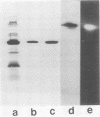Abstract
Pseudomonas aeruginosa elastase is a zinc metalloendopeptidase, probably responsible for the tissue destruction observed during infections with this organism. The elastase of a virulent Pseudomonas aeruginosa strain (Habs serotype 1) was isolated and found to have a molecular weight of 35,000; it readily degraded elastin and cartilage proteoglycans. A series of amino acid and peptide derivatives containing the metal-chelating moieties hydroxamate, phosphoryl, or thiol were synthesized and tested as potential inhibitors of the enzyme. Inhibition constants (Kis) for the compounds were determined with the chromophoric substrate furylacryloyl-glycyl-l-leucyl-l-alanine. The hydroxamic acid derivatives of benzyloxycarbonyl-glycine, benzyloxycarbonyl-l-leucine and benzyloxycarbonyl-l-phenylalanine had inhibition constants in the range of 11 to 28 μM. The 2-mercaptoacetyl derivatives of l-leucyl-d-phenylalanine and l-leucyl-l-phenylalanine had Ki values of 34 and 1.5 μM, respectively, demonstrating the stereospecificity of the inhibition. The most potent inhibitors tested were 2- mercaptoacetyl-l-phenylalanyl-l-leucine and phosphoryl-l-leucyl-l-phenylala-nine (Ki = 0.2 μM). Similar compounds lacking the metal-chelating moiety were about 3 orders of magnitude poorer inhibitors. When the inhibition of the enzyme activity towards azocasein, elastin, or cartilage was examined, inhibitor concentrations approximately 50-fold higher than the respective Kis were required to obtain 60 to 90% inhibition. Virtually complete inhibition was achieved with these substrates at inhibitor concentrations 500-fold higher than the respective Kis (0.1 to 14 mM). Although, 2-mercaptoacetyl-l-phenylalanyl-l-leucine and phosphoryl-l-leucyl-l-phenylalanine exhibited the same affinity to the enzyme, the latter was inferior in inhibiting cartilage proteoglycan degradation. 2-Mercaptoacetyl-l-phenylalanyl-l-leucine represents a class of potent elastase inhibitors that might prove useful in the management of P. aeruginosa infections.
Full text
PDF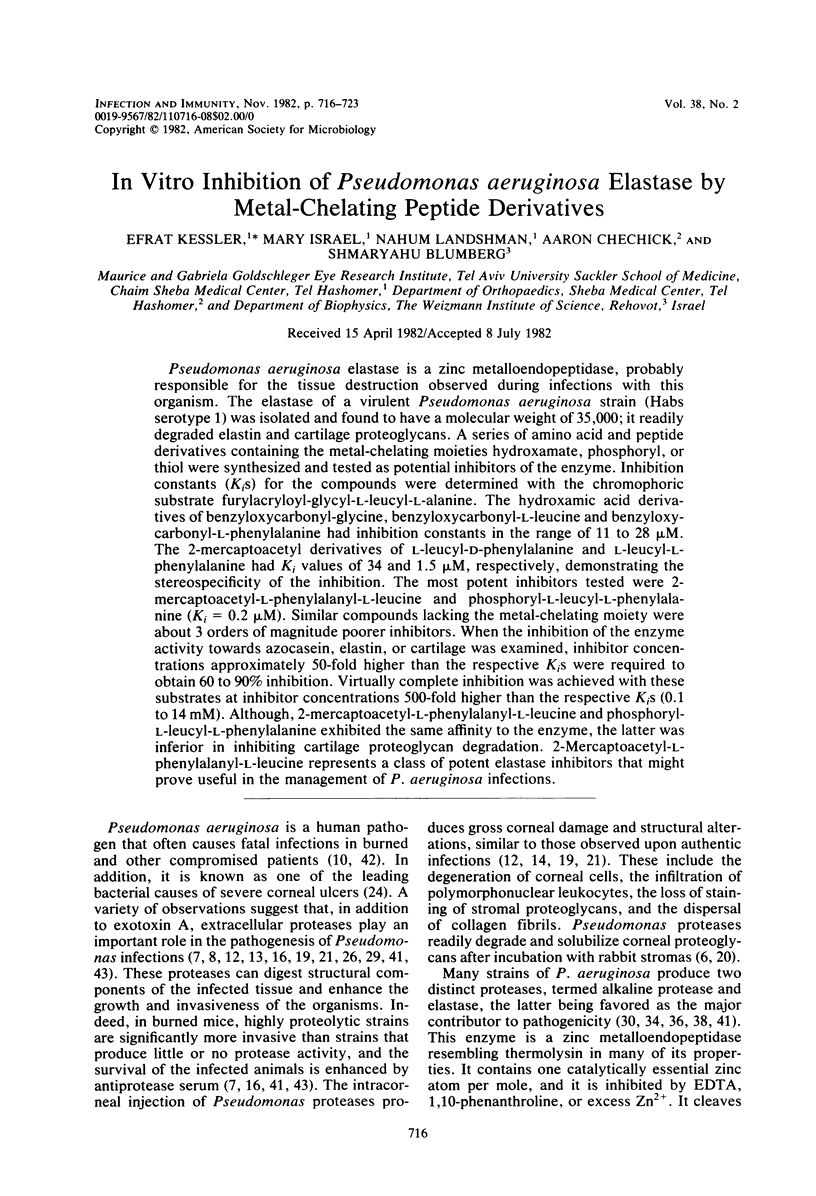
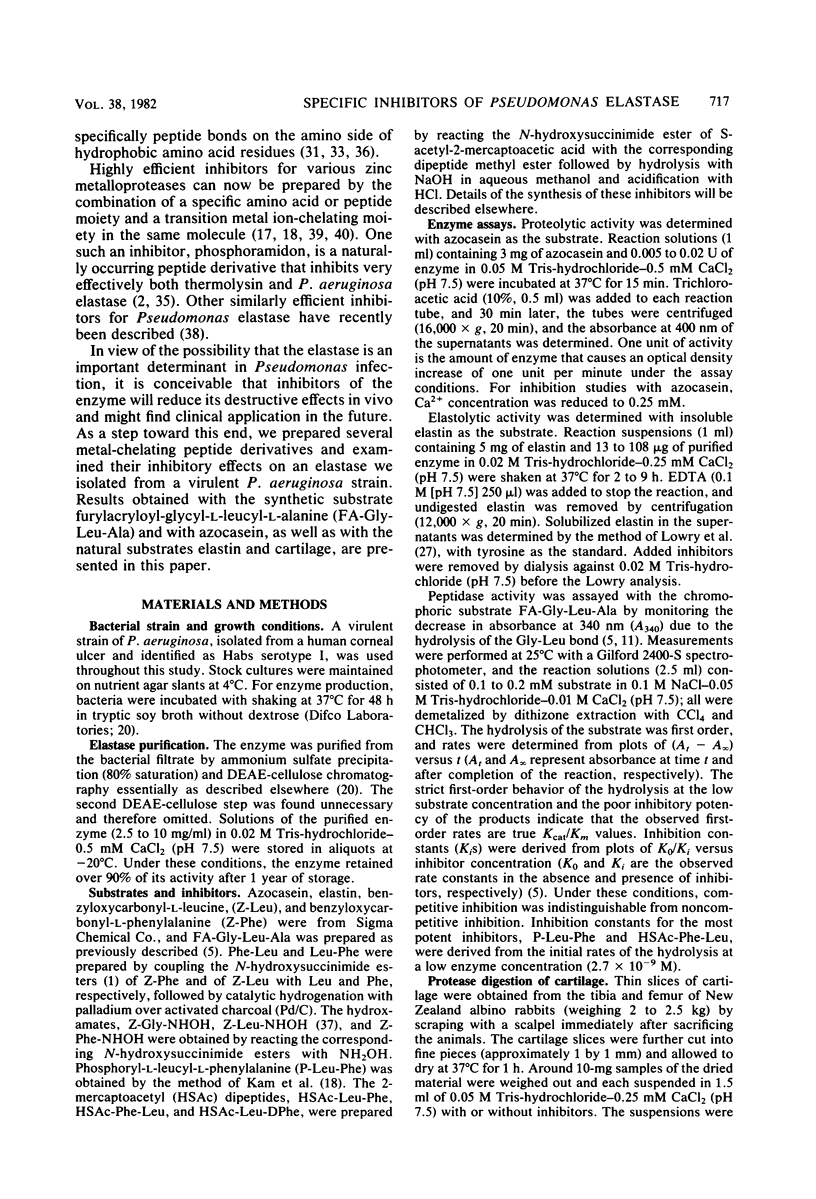
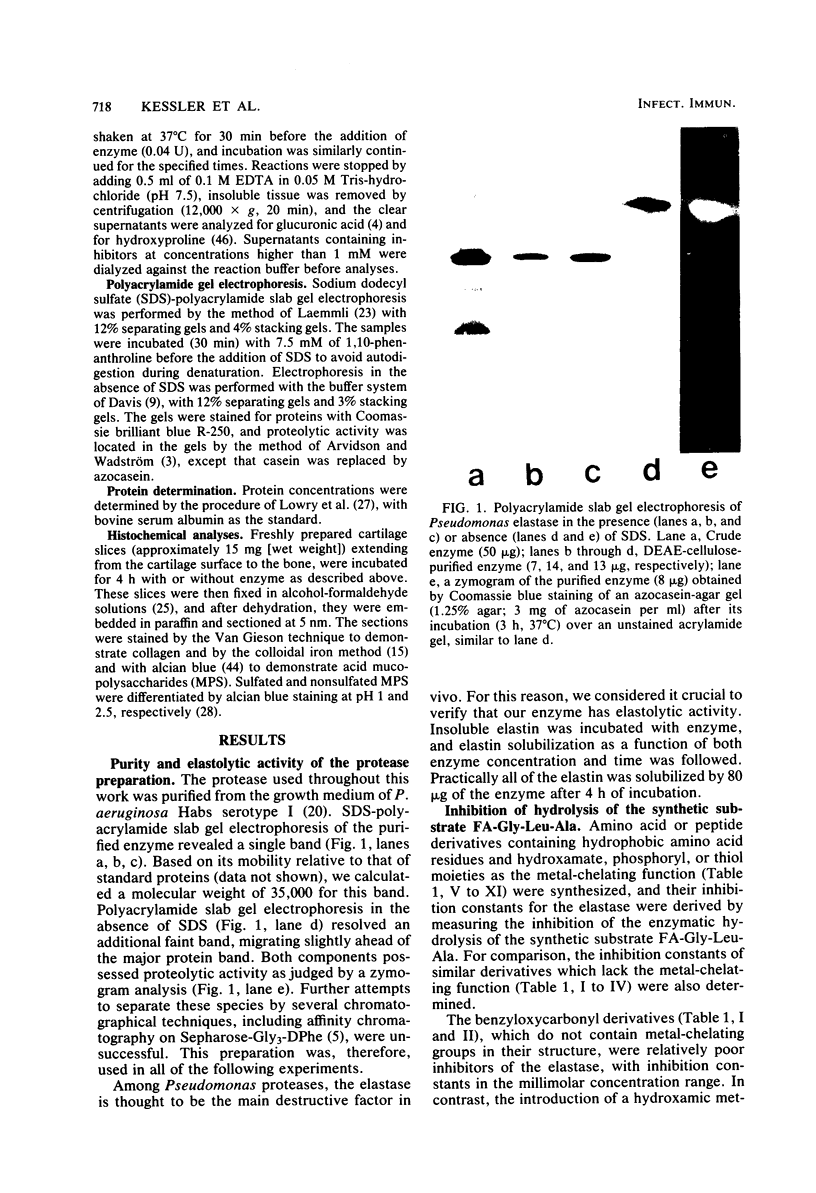
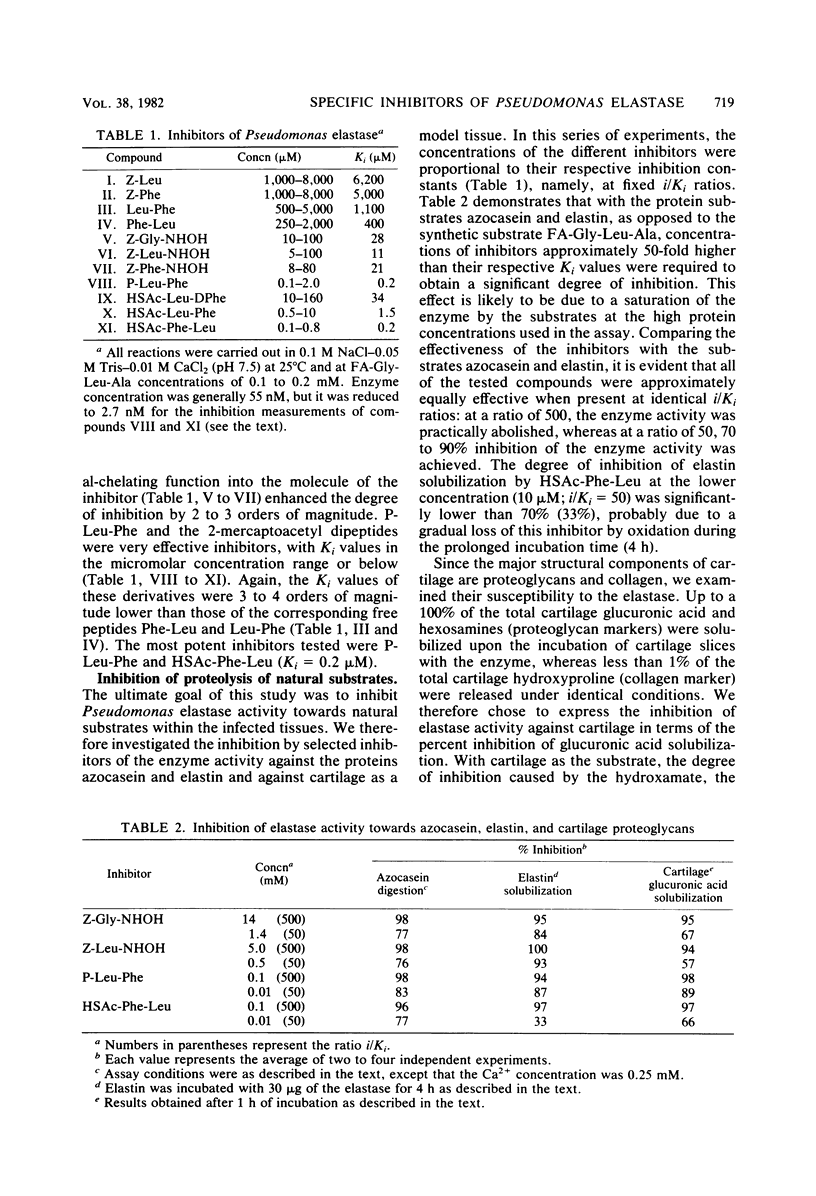
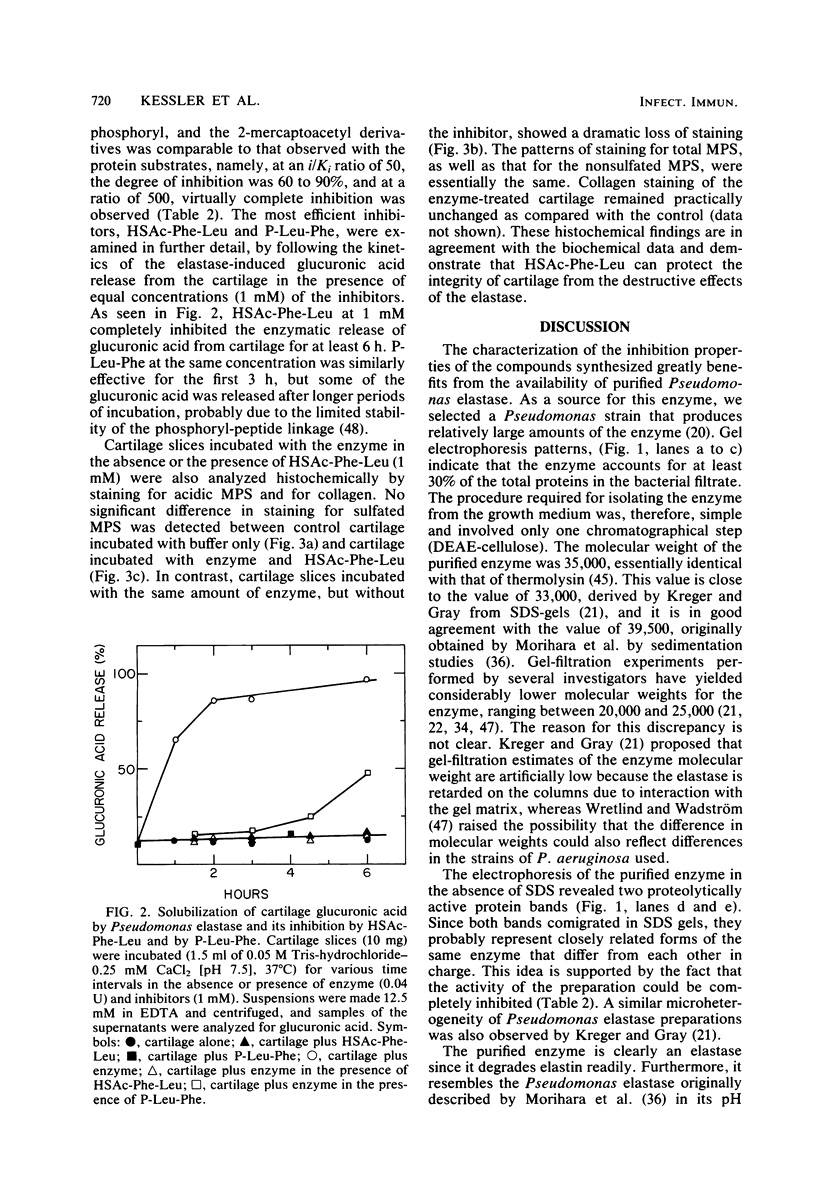
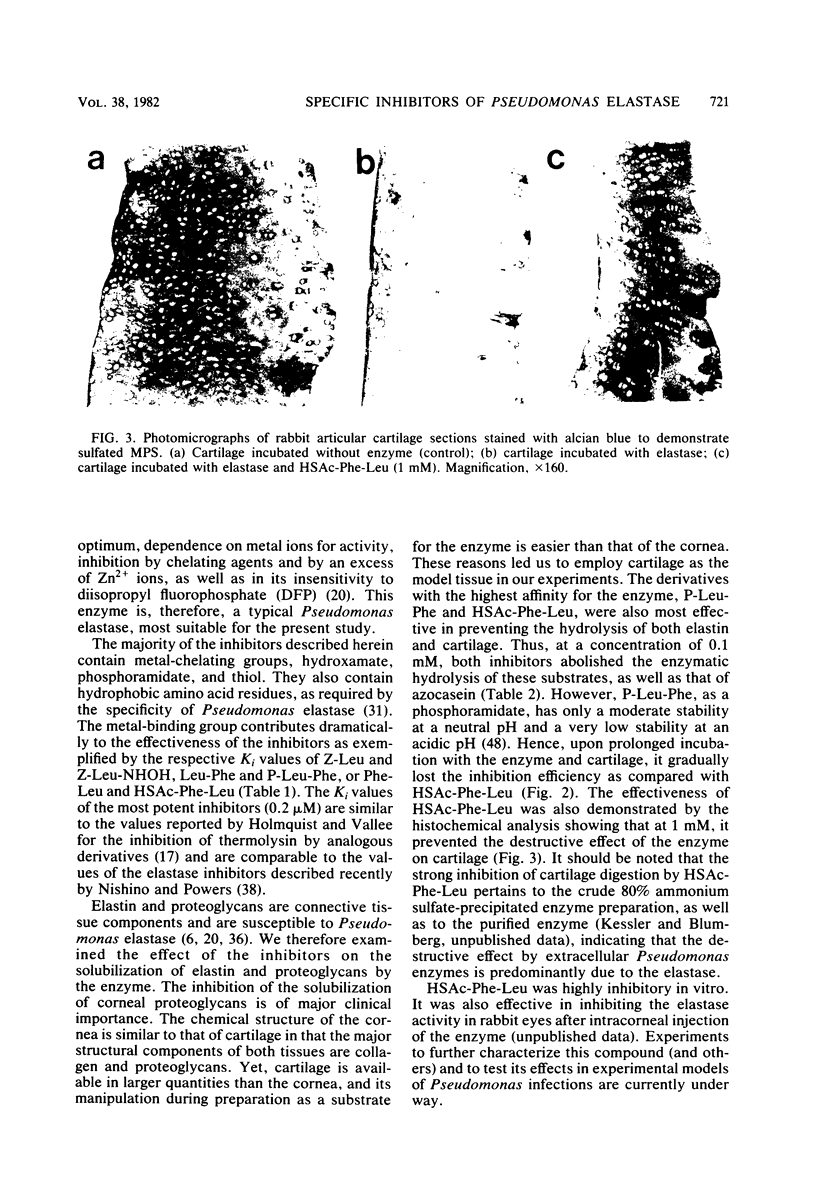
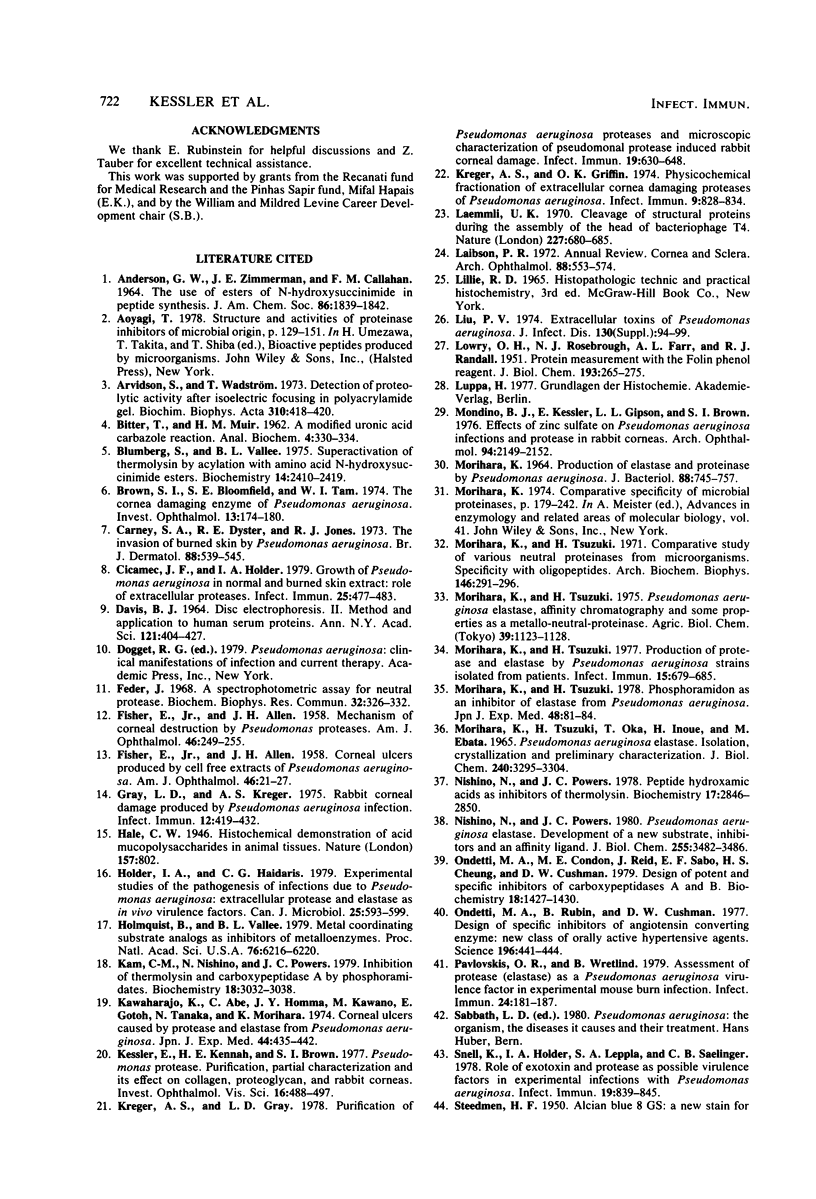
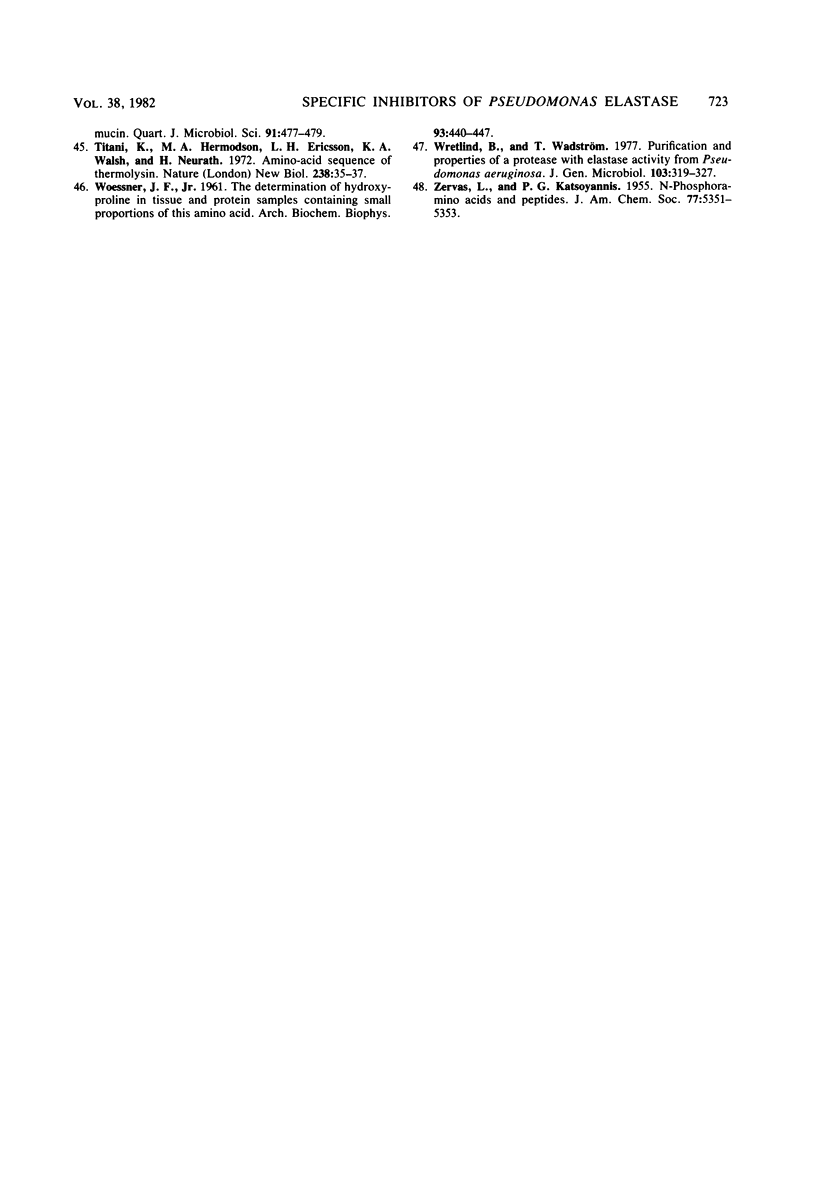
Images in this article
Selected References
These references are in PubMed. This may not be the complete list of references from this article.
- Arvidson S., Wadström T. Detection of proteolytic activity after isoelectric focusing in polyacrylamide gel. Biochim Biophys Acta. 1973 Jun 15;310(2):418–420. doi: 10.1016/0005-2795(73)90124-4. [DOI] [PubMed] [Google Scholar]
- BITTER T., MUIR H. M. A modified uronic acid carbazole reaction. Anal Biochem. 1962 Oct;4:330–334. doi: 10.1016/0003-2697(62)90095-7. [DOI] [PubMed] [Google Scholar]
- Blumberg S., Vallee B. L. Superactivation of thermolysin by acylation with amino acid N-hydroxysuccinimide esters. Biochemistry. 1975 Jun 3;14(11):2410–2419. doi: 10.1021/bi00682a022. [DOI] [PubMed] [Google Scholar]
- Brown S. I., Bloomfield S. E., Tam W. The cornea-destroying enzyme of Pseudomonas aeruginosa. Invest Ophthalmol. 1974 Mar;13(3):174–180. [PubMed] [Google Scholar]
- Carney S. A., Dyster R. E., Jones R. J. The invasion of burned skin by Pseudomonas aeruginosa. Br J Dermatol. 1973 Jun;88(6):539–545. doi: 10.1111/j.1365-2133.1973.tb08016.x. [DOI] [PubMed] [Google Scholar]
- Cicmanec J. F., Holder I. A. Growth of Pseudomonas aeruginosa in normal and burned skin extract: role of extracellular proteases. Infect Immun. 1979 Aug;25(2):477–483. doi: 10.1128/iai.25.2.477-483.1979. [DOI] [PMC free article] [PubMed] [Google Scholar]
- DAVIS B. J. DISC ELECTROPHORESIS. II. METHOD AND APPLICATION TO HUMAN SERUM PROTEINS. Ann N Y Acad Sci. 1964 Dec 28;121:404–427. doi: 10.1111/j.1749-6632.1964.tb14213.x. [DOI] [PubMed] [Google Scholar]
- FISHER E., Jr, ALLEN J. H. Corneal ulcers produced by cell-free extracts of Pseudomonas aeruginosa. Am J Ophthalmol. 1958 Jul;46(1 Pt 2):21–27. doi: 10.1016/0002-9394(58)90030-8. [DOI] [PubMed] [Google Scholar]
- FISHER E., Jr, ALLEN J. H. Mechanism of corneal destruction by pseudomonas proteases. Am J Ophthalmol. 1958 Nov;46(5 Pt 2):249–255. doi: 10.1016/0002-9394(58)90804-3. [DOI] [PubMed] [Google Scholar]
- Feder J. A spectrophotometric assay for neutral protease. Biochem Biophys Res Commun. 1968 Jul 26;32(2):326–332. doi: 10.1016/0006-291x(68)90389-6. [DOI] [PubMed] [Google Scholar]
- Gray L. D., Kreger A. S. Rabbit corneal damage produced by Pseudomonas aeruginosa infection. Infect Immun. 1975 Aug;12(2):419–432. doi: 10.1128/iai.12.2.419-432.1975. [DOI] [PMC free article] [PubMed] [Google Scholar]
- Holder I. A., Haidaris C. G. Experimental studies of the pathogenesis of infections due to Pseudomonas aeruginosa: extracellular protease and elastase as in vivo virulence factors. Can J Microbiol. 1979 May;25(5):593–599. doi: 10.1139/m79-085. [DOI] [PubMed] [Google Scholar]
- Holmquist B., Vallee B. L. Metal-coordinating substrate analogs as inhibitors of metalloenzymes. Proc Natl Acad Sci U S A. 1979 Dec;76(12):6216–6220. doi: 10.1073/pnas.76.12.6216. [DOI] [PMC free article] [PubMed] [Google Scholar]
- Kam C. M., Nishino N., Powers J. C. Inhibition of thermolysin and carboxypeptidase A by phosphoramidates. Biochemistry. 1979 Jul 10;18(14):3032–3038. doi: 10.1021/bi00581a019. [DOI] [PubMed] [Google Scholar]
- Kawaharajo K., Abe C., Homma J. Y., Kawano M., Goto E. Corneal ulcers caused by protease and elastase from Pseudomonas aeruginosa. Jpn J Exp Med. 1974 Oct;44(5):435–442. [PubMed] [Google Scholar]
- Kessler E., Kennah H. E., Brown S. I. Pseudomonas protease. Purification, partial characterization, and its effect on collagen, proteoglycan, and rabbit corneas. Invest Ophthalmol Vis Sci. 1977 Jun;16(6):488–497. [PubMed] [Google Scholar]
- Kreger A. S., Gray L. D. Purification of Pseudomonas aeruginosa proteases and microscopic characterization of pseudomonal protease-induced rabbit corneal damage. Infect Immun. 1978 Feb;19(2):630–648. doi: 10.1128/iai.19.2.630-648.1978. [DOI] [PMC free article] [PubMed] [Google Scholar]
- Kreger A. S., Griffin O. K. Physicochemical fractionation of extracellular cornea-damaging proteases of Pseudomonas aeruginosa. Infect Immun. 1974 May;9(5):828–834. doi: 10.1128/iai.9.5.828-834.1974. [DOI] [PMC free article] [PubMed] [Google Scholar]
- LOWRY O. H., ROSEBROUGH N. J., FARR A. L., RANDALL R. J. Protein measurement with the Folin phenol reagent. J Biol Chem. 1951 Nov;193(1):265–275. [PubMed] [Google Scholar]
- Laemmli U. K. Cleavage of structural proteins during the assembly of the head of bacteriophage T4. Nature. 1970 Aug 15;227(5259):680–685. doi: 10.1038/227680a0. [DOI] [PubMed] [Google Scholar]
- Laibson P. R. Cornea and sclera. Arch Ophthalmol. 1972 Nov;88(5):553–574. doi: 10.1001/archopht.1972.01000030555018. [DOI] [PubMed] [Google Scholar]
- MORIHARA K. PRODUCTION OF ELASTASE AND PROTEINASE BY PSEUDOMONAS AERUGINOSA. J Bacteriol. 1964 Sep;88:745–757. doi: 10.1128/jb.88.3.745-757.1964. [DOI] [PMC free article] [PubMed] [Google Scholar]
- MORIHARA K., TSUZUKI H., OKA T., INOUE H., EBATA M. PSEUDOMONAS AERUGINOSA ELASTASE. ISOLATION, CRYSTALLIZATION, AND PRELIMINARY CHARACTERIZATION. J Biol Chem. 1965 Aug;240:3295–3304. [PubMed] [Google Scholar]
- Mondino B. J., Kessler E., Gipson L. L., Brown S. I. Effects of zinc sulfate on Pseudomonas aeruginosa infections and protease in rabbit corneas. Arch Ophthalmol. 1976 Dec;94(12):2149–2152. doi: 10.1001/archopht.1976.03910040809015. [DOI] [PubMed] [Google Scholar]
- Morihara K. Comparative specificity of microbial proteinases. Adv Enzymol Relat Areas Mol Biol. 1974;41(0):179–243. doi: 10.1002/9780470122860.ch5. [DOI] [PubMed] [Google Scholar]
- Morihara K., Tsuzuki H. Comparative study of various neutral proteinases from microorganisms: specificity with oligopeptides. Arch Biochem Biophys. 1971 Sep;146(1):291–296. doi: 10.1016/s0003-9861(71)80066-8. [DOI] [PubMed] [Google Scholar]
- Morihara K., Tsuzuki H. Phosphoramidon as an inhibitor of elastase from Pseudomonas aeruginosa. Jpn J Exp Med. 1978 Feb;48(1):81–84. [PubMed] [Google Scholar]
- Morihara K., Tsuzuki H. Production of protease and elastase by Pseudomonas aeruginosa strains isolated from patients. Infect Immun. 1977 Mar;15(3):679–685. doi: 10.1128/iai.15.3.679-685.1977. [DOI] [PMC free article] [PubMed] [Google Scholar]
- Nishino N., Powers J. C. Peptide hydroxamic acids as inhibitors of thermolysin. Biochemistry. 1978 Jul 11;17(14):2846–2850. doi: 10.1021/bi00607a023. [DOI] [PubMed] [Google Scholar]
- Nishino N., Powers J. C. Pseudomonas aeruginosa elastase. Development of a new substrate, inhibitors, and an affinity ligand. J Biol Chem. 1980 Apr 25;255(8):3482–3486. [PubMed] [Google Scholar]
- Ondetti M. A., Condon M. E., Reid J., Sabo E. F., Cheung H. S., Cushman D. W. Design of potent and specific inhibitors of carboxypeptidases A and B. Biochemistry. 1979 Apr 17;18(8):1427–1430. doi: 10.1021/bi00575a006. [DOI] [PubMed] [Google Scholar]
- Ondetti M. A., Rubin B., Cushman D. W. Design of specific inhibitors of angiotensin-converting enzyme: new class of orally active antihypertensive agents. Science. 1977 Apr 22;196(4288):441–444. doi: 10.1126/science.191908. [DOI] [PubMed] [Google Scholar]
- Pavlovskis O. R., Wretlind B. Assessment of protease (elastase) as a Pseudomonas aeruginosa virulence factor in experimental mouse burn infection. Infect Immun. 1979 Apr;24(1):181–187. doi: 10.1128/iai.24.1.181-187.1979. [DOI] [PMC free article] [PubMed] [Google Scholar]
- Snell K., Holder I. A., Leppla S. A., Saelinger C. B. Role of exotoxin and protease as possible virulence factors in experimental infections with Pseudomonas aeruginosa. Infect Immun. 1978 Mar;19(3):839–845. doi: 10.1128/iai.19.3.839-845.1978. [DOI] [PMC free article] [PubMed] [Google Scholar]
- Wretlind B., Wadström T. Purification and properties of a protease with elastase activity from Pseudomonas aeruginosa. J Gen Microbiol. 1977 Dec;103(2):319–327. doi: 10.1099/00221287-103-2-319. [DOI] [PubMed] [Google Scholar]



